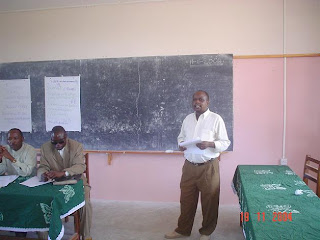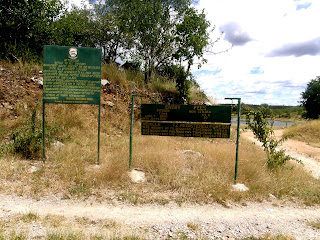
 I traveled with the vehicle with the registration No: T947 AVG a property of Tatanca Tours & Safaris Company based in Iringa.
I traveled with the vehicle with the registration No: T947 AVG a property of Tatanca Tours & Safaris Company based in Iringa.I thought my journey could have some implications on the way as I thought of the long distance I had to cover along the rough and corrugated road, but the driver who is experienced in tour guide, has worked in different tour companies for the last 20 years, gave me a hope and assured that we would go and return safely. Charles Masonda, (48) an expert driver narrated to me a bit of the geographical situation of the area and about the road he passed through, despite of the situation, the area is full of thick and darkened forests all the way and you could think there were no people living into the interior. All the way through we could hardly see vehicles on the way as most transporters shun their passenger vehicles to operate in the area because of its situation. Only few that could be seen. As he was driving, the driver kept me busy narrating stories to me on the most important things about the park and the wildlife in general.
 Many transporters have shun the road going to Ruaha national park, an aspect that compels passengers to use sometimes pick ups or canters that serves as means of transport along the road
Many transporters have shun the road going to Ruaha national park, an aspect that compels passengers to use sometimes pick ups or canters that serves as means of transport along the roadMasonda who holds a Diploma in tour guide operation has ever worked in three big tour companies based in Arusha which serves the northern tourist circuit in the country. He said some portion of the main road is sometimes impassable during rainy season, and I also witnessed myself as I passed along, quite large portion of the main road is full of potholes that I could sometimes feel the inconveniences while traveling. But I didn’t mind for I know this is how the situation of most roads especially in our rural areas looks like. But I came to .learn that, the government through the Ministry of Natural Resources and Tourist has really hard time indeed to effectively ensure safety by repairing these roads. Likewise, Tanzania Tourist Board (TTB) needs to put some pressure on the government to take keen interest on the issue in a bid to ward off the prevailing situation which according to tourist experts it exists mostly in national parks located in southern circuit. Little is done to improve the situation, and this is a challenge to the government to ensure that it rectifies the situation so that tourists visiting the area should enjoy their journey.
 A sign post by the side of the main road to Ruaha Rational park showing the site of Mkwawa Museum about 1 km.
A sign post by the side of the main road to Ruaha Rational park showing the site of Mkwawa Museum about 1 km.For a couple of 10 minutes, we had reached Kalenga village which is 15 kilometers west of Iringa town along the road going to Ruaha National Park. The presence of a sign post with an arrow indicating Mkwawa Museum stationed slightly by the side of the road, was an indication of the theory which I read while I was schooling in primary school that of a famous historic village known of having fiercely local warriors who fought the German colonialists of the past in late 1890s. Kalenga village is an important place which has a significant historical background, not only to the nation but the history of the place has brought fame also to a very well-known ethnic group in Southern Highland region. Getting there during rainy seasons is a little bit difficult than what one could expect. The inhabitants of the area are mostly the Hehe ethnic group, the tribe’s historic nature has created superiority among the people and is still rests in everybody’s mind including historians of the past and present. This is too legend that is still being told up to today.
 Another sign post also located along the main road to Ruaha national park showing the exact spot where a hero of the Hehe ethnic group, Chief Mkwawa was buried. It’s about 11 Km from there to a place known as Mlambalasi, it’s among the most tourist attractions of the southern highland region.
Another sign post also located along the main road to Ruaha national park showing the exact spot where a hero of the Hehe ethnic group, Chief Mkwawa was buried. It’s about 11 Km from there to a place known as Mlambalasi, it’s among the most tourist attractions of the southern highland region.Many people regardless of their age have lots of information as regards the area for their mostly respected ancestral groups of elders originated from. Therefore the Museum shows various war equipment that the legend Hehe leader locally known as ‘Mtwa Mkwawa’ or Chief Mkwawa used in his protest against the German invasion, and more fascinating is his skull which has a bullet wound where he shot himself for fear of being humiliated by his adversaries before he could be captured and made a war prisoner by the German troops. About one and a half hours, we had reached to a certain area where there is a steep and then a slope downward, it’s at this point whereby my driver Mr. Masonda stopped and asked me to take a photo of the scenery whose background showed Ruaha national park with an airstrip closely built which is seen far to the distant horizon. The scenery is greenish with trees well maintained and preserved as game reserve area according to the law as stipulated by Tanzania National Park (TANAPA).
 The scenery in the background shows Ruaha national park zone as it can be viewed while standing from this spot.
The scenery in the background shows Ruaha national park zone as it can be viewed while standing from this spot.Whenever tourists roams within the park, they feel like walking in a cool and a pleasant area that is free of noise of any kind, there is no any mobile phone communication as there are no communication towers to transmit the phone calls. Only the presence of animals and the melodious sounds of different bird species could be seen dominating the surroundings. Or sometimes you could be terrified by a sudden groups of herbivorous animals who takes to their heels up in hot pursuit and comes to discover that, were escaping away from the sight of lioness from unknown direction. It’s like a drama that shows someone who takes to his heels to escape death. These are normal things happening within the park as you know lions are terrified animals. About the history and the geography of the Ruaha National Park is that the park is located in Southern highland region covering the southern tourist circuit, and it’s the largest park in the country covering an area of about 22,200 square Km.






























































